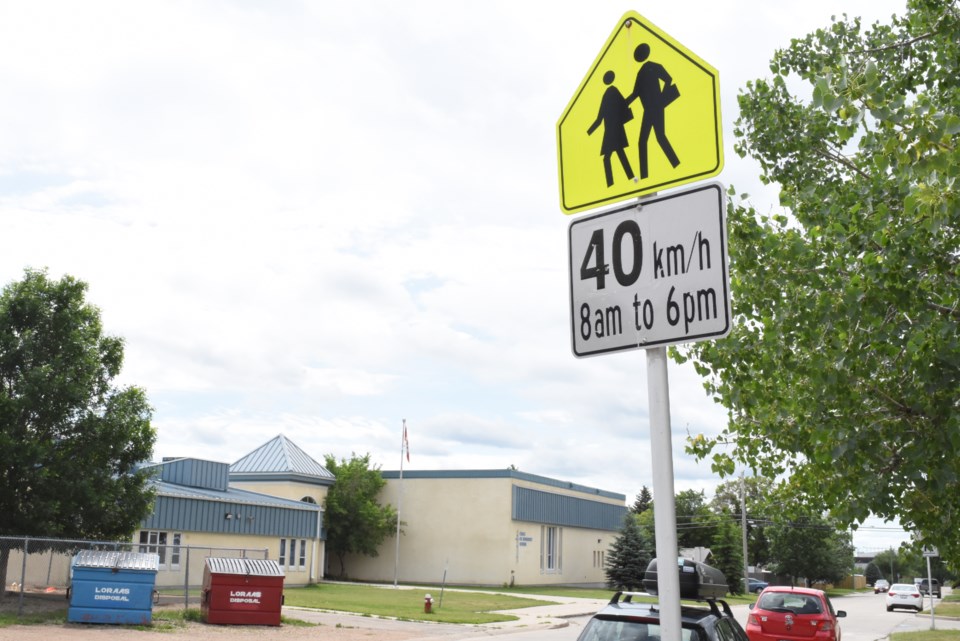Motorists will be driving 10 kilometres per hour slower come September as city hall will reduce speeds in school zones and playgrounds to enhance safety and align with other jurisdictions.
City hall is relying on its transportation master plan (TMP) to guide upgrades to road infrastructure, high-priority intersections, signage and road paint markings and be compliant with the Manual for Uniform Traffic Control Devices of Canada (MUTCDC), an April 22 city council report explained.
Last spring, contractor KGS Group completed an evaluation of school zones, spoke with both school divisions about their traffic concerns, reviewed current safety measures and identified issues with winter driving before providing city hall with a draft report.
Hold your horses
One recommendation is to reduce speed limits in school zones and playgrounds and near public venues from 40 kilometres per hour to 30 km/h and enforce that speed from 7 a.m. to 7 p.m. seven days a week.
“Apart from the known increase in student/pedestrian safety that this provides, Moose Jaw is the last city in Saskatchewan with a significant population (over 5,000 people) to make this transition,” the report said.
KGS also said this is “best practice and consistent with the national guidelines and (with what) the majority of Canadian municipalities (have already done).”
Many upgrades
City hall will start overhauling the 20 school zones this summer by adding or improving pedestrian ramps, updating nearly 120 signs to reflect MUTCDC standards and reducing speeds, said the report. City crews should complete sign changes when the 2024-25 school year starts in September.
The city has budgeted $4,215,000 during the next five years to address traffic control issues, including school zone changes; $725,000 is budgeted this year.
Also, this year, the municipality will update and replace pedestrian ramps and refresh and adjust line painting to accommodate pedestrian corridors. Next year, it will continue updating school zone signs and replace signs at detached playgrounds and near other public venues like the Kinsmen Sportsplex.
Council comments
Coun. Doug Blanc thought this was a great project, while he hoped it addressed problem areas where motorists drive “excessively fast,” such as near Cornerstone Christian School and on Ninth Avenue Northwest.
Furthermore, he thought the time was more realistic than the current 8 a.m. to 6 p.m. because he’s seen kids walking to school early in the morning and knows youths stay after for sports.
“I know 30 km/h is extremely slow, but wow, I would hate to see any child hit because somebody was going over the speed limit — and they go over the speed limit now,” Blanc added.
Coun. Crystal Froese agreed with the Cornerstone concerns, saying while there are pedestrian lights and a speed clock near there, many large trucks still coming barrelling in from Highway 2.
Furthermore, while speed limits decreased quickly from 70 km/h to 50 km/h to 40 km/h on Main Street South, she wanted city hall to reduce the speed limit even further out before motorists reached the residential area.
Coun. Kim Robinson questioned the need to reduce the speed limit — he acknowledged needing to protect people — since letters from stakeholders said they had no problems with 40 km/h, while there have been zero incidents in the past five years.
“… why wouldn’t we change it to 20 km/h, then? Where do we draw the line on this? We just fall in line because we’re the last community (to change) … ?” he said, adding he believed the new school was contributing to this.
Coun. Dawn Luhning was also concerned, saying she wasn’t necessarily worried about people’s safety but the fact there seemed to be school zones or playgrounds in every area of the city. She worried that reducing the speed limit would make travelling slower.
“We might as well change the entire city to 40 km/h (except Thatcher Drive) … ,” she continued.
The Downtown Moose Jaw Association has also been advocating for slower speeds because the double lanes at 50 km/h are dangerous for pedestrians, Luhning added. She thought it was a good idea to consider that, too.
Coun. Heather Eby recalled moving to Moose Jaw decades ago and hearing about a petition to reduce speeds in school zones after a “horrible accident” occurred in one. She noted that people then also thought it would be “the most horrible thing in the world” to drop speeds — then, to 40 km/h.
Public engagement
City administration contacted 11 stakeholders in March about these changes, including Saskatchewan Government Insurance (SGI), police, fire and EMS, Prairie South and Holy Trinity Catholic school divisions, École Ducharme, the Francophone community, both MLAs and the RCMP detachment, the council report said.
In its letter, SGI said research shows that for every one km/h reduction in speed, crash risks are reduced by two to three per cent. In Moose Jaw, the Crown corporation said reducing the speed limit to 30 km/h would enhance safety — the maximum recorded speed through a school zone has been 74 km/h — and would align with Regina and Saskatoon.
“While reducing the speed limit may lead to some traffic congestion and non-compliance by certain drivers, the potential benefits of enhanced safety and consistency with other jurisdictions are significant … ,” the letter said.
“This collective effort can lead to a safer and more harmonious community.”
SGI twice recommended that city hall engage with the community to discuss the proposed changes and raise awareness about them through campaigns to ensure successful implementation.
Meanwhile, Moose Jaw police said it had recorded zero pedestrian collisions in school zones from Jan. 1, 2019, to now; the fire department’s only concern was about how changes would affect the intersection near Sunningdale School; and EMS said its ability to respond to emergencies could be affected since it normally drives 10 per cent over posted speed limits.
The next regular council meeting is Monday, May 13.




